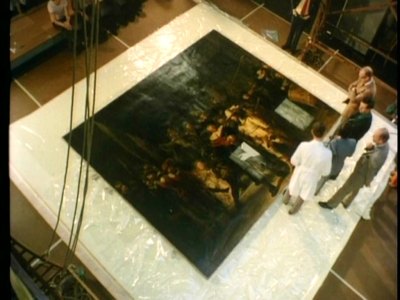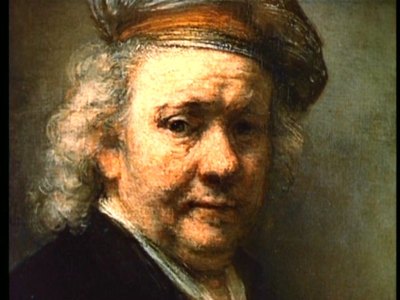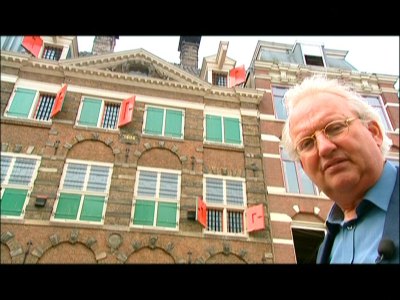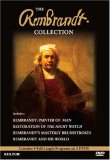| Reviews & Columns |
|
Reviews DVD TV on DVD Blu-ray 4K UHD International DVDs In Theaters Reviews by Studio Video Games Features Collector Series DVDs Easter Egg Database Interviews DVD Talk Radio Feature Articles Columns Anime Talk DVD Savant Horror DVDs The M.O.D. Squad Art House HD Talk Silent DVD
|
DVD Talk Forum |
|
|
| Resources |
|
DVD Price Search Customer Service #'s RCE Info Links |
|
Columns
|
|
|
Rembrandt Collection, The
From Kultur comes The Rembrandt Collection, a marvelous two-disc compilation of four separate documentaries on the famous 17th century Dutch painter, Rembrandt van Rijn. Each short documentary (the longest one runs only forty-one minutes) takes a markedly different cinematic approach to illustrate the life and work of this giant in the world of painting, giving the viewer a unique opportunity to more fully understand the true genius of Rembrandt's output, as well as the drama of his personal life. Let's look at each documentary.
REMBRANDT: PAINTER OF MAN (REMBRANDT, SCHILDER VAN DE MENS)

Produced in 1957, this beautifully edited nineteen minute documentary on Rembrandt was an international art house hit, and a contender at the Cannes Film Festival. Directed by Bert Haanstra, Rembrandt: Painter of Man uses only images painted by Rembrandt to tell the story of his life, narrated in carefully measured tones by an unnamed speaker. Photographed in Technicolor by Stanley Sayer, and accompanied by Jan Mul's lyrical musical soundtrack, Rembrandt: Painter of Man's tone is one of equal joy and sadness at the life of the great artist. In its short running time, there's a surprising amount of information imparted to the viewer, including major themes that run through Rembrandt's work: the celebration of mankind; the use of Bible images (particularly when Rembrandt is going through difficult periods in his life); the use of self-portraits to express his own happiness or depression, and for a brief period, the sanctity of marriage and happy union. Rembrandt: Painter of Man is particularly memorable in limiting itself only to images from Rembrandt's paintings; we get a crash course in appreciating the astonishing effects of shadow and light that he mastered, as well as the almost haunting quality of his startlingly effective portraitures.
The DVD:
The Video:
There are quite a few anomalies in the original materials used for the DVD transfer, including plenty of scratches and dirt specks, but I can't stress enough how unimportant that is to enjoying Rembrandt: Painter of Man. The DVD image here is exactly the way I remember viewing Rembrandt: Painter of Man back when I was studying art history in college, providing a nice nostalgic jolt. Everything doesn't have to look like HD-DVD.
The Audio:
The audio for Rembrandt: Painter of Man sounds just like it did when I saw a 16mm print of this documentary back in college: plenty of pops and snaps on the optical track. And that's just the way I want it to stay. There are no subtitles or close-captioning options.
The Extras:
There are no extras for Rembrandt: Painter of Man.
Final Thoughts:
If you ever took an art history class in college, you may very well have seen this justly celebrated documentary -- or one very similar to it. It's instantly recognizable as a reverent, intelligent treatise from the 1950s on this great artist. I can't recommend Rembrandt: Painter of Man highly enough for you.
RESTORATION OF THE NIGHT WATCH

I tried quite a few sources to find out more information on this fascinating 1976 documentary on the restoration of Rembrandt's damaged The Night Watch, but I came up blank. Not being able to read Dutch (the credits are in Dutch, but the narration is dubbed in English), and with no background information offered in the DVD set, I can't tell you much about its production background, except that it was directed by Theo Kok. What I can say about the thirty-five minute Restoration of The Night Watch is that it's an absorbing look at the incredibly laborious, detailed work that goes into radical art restoration.
Severely slashed in seven different places by a deranged patron at Amsterdam's Rijksmuseum in 1975, Rembrandt's famous large-scale painting, The Night Watch underwent a painstaking eight month-long restoration project that not only repaired the tears in the canvas, but that also stabilized the deteriorating canvas as a whole, along with the art restorers stripping off the old varnish to put a new layer on the delicate painting. Restoration of The Night Watch, obviously made with the cooperation of the Rijksmuseum, details all of the steps that went into repairing the picture. A tedious procedure of applying thread stitching to the back of the tears is then reinforced by applying a brand new canvas backing to Rembrandt's original canvas, which could no longer support the weight of the paint. Then, the old coat of varnish on the front of the painting was scrubbed off, and a new layer added by brush. Finally, touch-up painting by the museum's historian finishes the job (no text is given for his name, and quite honestly, I couldn't figure out how to spell it from the narration, so I left it out, rather than misspell it) .
What I found most fascinating about Restoration of The Night Watch is how "rough," for lack of a better word, old restoration techniques were back in 1975. I could very well be wrong, but I have a feeling procedures have changed quite a bit since then when it comes to restoring great works of art (when the handlers move the painting, they're not even using gloves!). Perhaps most unsettling is when the old varnish is scrubbed off, and a new varnish - which I assume is animal-based - is literally swiped onto the canvas, with big, heavy brushes, the canvas flexing alarmingly. If I'm wrong, and that's the way they still do such restoration, please email me, but it's certainly wild to see these guys at work, scrubbing away at that canvas. But to be fair, The Night Watch still stands in the Rijksmuseum to this day, so what they did must have worked.
The DVD:
The Video:
The full screen video image for Restoration of The Night Watch is fairly faded, but the focus of this documentary isn't to show off Rembrandt's work, but the efforts of the art restorers, so the sometimes compromised original elements aren't really a factor in enjoying the show.
The Audio:
The English mono soundtrack is rough, as well (with no subtitles or close-captioning), but I'm telling you; there's this weird musical cue they use, every time the painting is moved, that alone is worthy of the price of admission. When that chunky funk groove comes on, totally at odds with what you're watching, you're right smack dab in the middle of 1976 again -- and loving it.
The Extras:
There are no extras for Restoration of The Night Watch.
Final Thoughts:
Detailing the amazingly complex -- but at the same time, surprisingly crude (for 1975) -- techniques of art restoration, Restoration of The Night Watch is a fascinating look back at the herculean efforts to save the badly damaged Rembrandt masterpiece. It's a cool time capsule, and I highly recommend it.
REMBRANDT'S MASTERLY BRUSHSTROKES

Produced in 1999 by Dutch chemical company DSM, Rembrandt's Masterly Brushstrokes may not be the most exciting documentary you've ever seen -- its subject is the composition of Rembrandt's paint -- but it is informative, and in the context of this collection of documentaries, quite necessary. Hosted by Rembrandt Research Project member and expert on Rembrandt's life and work, Ernst van de Wetering, Rembrandt's Masterly Brushstrokes starts out like an industrial training film, but becomes quite interesting as it starts to connect the dots between the chemical research into Rembrandt's paint, and his life work.
Rembrandt's Masterly Brushstrokes concerns itself mainly with trying to find out why Rembrandt's brushstrokes were so rough (seen under a microscope, they look like the lunar surface). Determined by experts to be a deliberate attempt by Rembrandt to have light "sparkle" over the canvas (and not to be the world's first "Expressionist," as some historians have put forth), van de Wetering and scientists at DSM discover that the specific type of paints used by Rembrandt created the unique liquid/viscosity levels that were crucial to achieving his unique effect. What we may see today as Rembrandt having to deal with relatively "crude" tools - handmade paint - was actually a highly sophisticated artistic choice that yielded results difficult to duplicate today.
Rembrandt's Masterly Brushstrokes, once it gets started on its journey to track down the ingredients of Rembrandt's paint, is quite exciting, and proves the point that there are no boring documentary subjects, just boring documentaries. The film technique of Rembrandt's Masterly Brushstrokes may not be thrilling; it's presented in a rather dry, technical way. However, the obvious thrill of finding out how Rembrandt actually achieved his technique starts to come through, and with more and more examples of Rembrandt's work showing up towards the end of the documentary, Rembrandt's Masterly Brushstrokes evolves into a pretty exciting history/science lesson.
The DVD:
The Video:
The full screen video image for Rembrandt's Masterly Brushstrokes is good; shot on video, it looks fine on a small monitor or TV, but you're going to have compression issues show up moving to a larger screen. Colors are natural and properly hued.
The Audio:
The Dolby Digital 2.0 English stereo mix is fine, with all the speakers coming through clearly and cleanly. No subtitles or close-captioning are available.
The Extras:
There are no extras for Rembrandt's Masterly Brushstrokes.
Final Thoughts:
Perhaps a little dry at the beginning, Rembrandt's Masterly Brushstrokes soon turns into a pretty involving little scientific mystery, and in the context of this DVD set, The Rembrandt Collection, it's valuable viewing. I recommend Rembrandt's Masterly Brushstrokes.
REMBRANDT AND HIS WORLD

Produced for Dutch television in 2000, Rembrandt and His World will probably be the most familiar kind of documentary for viewers of this DVD set. Hosted again by Rembrandt Research Project member and expert on Rembrandt's life and work, Ernst van de Weterin, Rembrandt and His World is a carefully constructed, straightforward historical documentary that resembles most of the programs you'd see on The History Channel today. Focusing on the amazing restoration of Rembrandt's house and studio in Amsterdam, Rembrandt and His World goes on location to show the various buildings and neighborhoods that Rembrandt grew up in and lived, while illustrating his life story with frequent shots of his work.
Of course, those location shots are a marvelous addition to the rest of the documentaries here in this collection, because they give a context for the previous information presented about the great painter. As well, the fabulous restoration of Rembrandt's studio gives the viewer a visceral sense of exactly how Rembrandt toiled artistically. van de Weterin is a genial and informative host, and Rembrandt and His World comes off as a welcome summary for the previous three documentaries.
The DVD:
The Video:
The widescreen, 1.78:1 video image for Rembrandt and His World looks good on a small TV, but ghosting and compression issues do appear when viewed on a large monitor. Still, it's not a deal breaker for this kind of film.
The Audio:
The Dolby Digital 2.0 English stereo mix is quite nice, with the beautiful score perfectly balanced against the narration. No close-captioning or subtitles are available.
The Extras:
There are no extras for Rembrandt and His World.
Final Thoughts:
Rembrandt and His World is an informative, succinctly executed look at Rembrandt's life and work, as seen through his paintings, the places he lived, and the studio in which he worked. It's a fine summary for the previous three documentaries. I highly recommend Rembrandt and His World.
Final Thoughts on the DVD set:
The Rembrandt Collection offers a unique opportunity for art lovers to experience four distinctly different approaches in documentary filmmaking, giving the viewer a fully-rounded look at the great 17th century master painter, Rembrandt, and his work. The only drawback is that Kultur didn't provide any background on the actual documentaries; that would have been a helpful touch. Still, I highly recommend Kultur's two-disc, four documentary set, The Rembrandt Collection.
Paul Mavis is an internationally published film and television historian, a member of the Online Film Critics Society, and the author of The Espionage Filmography.


|
| Popular Reviews |
| Sponsored Links |
|
|
| Sponsored Links |
|
|
| Release List | Reviews | Shop | Newsletter | Forum | DVD Giveaways | Blu-Ray | Advertise |
|
Copyright 2024 DVDTalk.com All Rights Reserved. Legal Info, Privacy Policy, Terms of Use,
Manage Preferences,
Your Privacy Choices | |||||||














